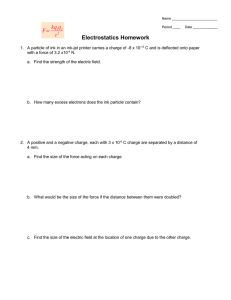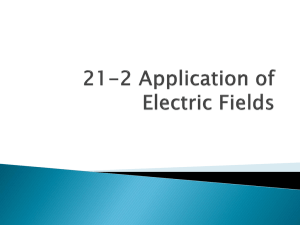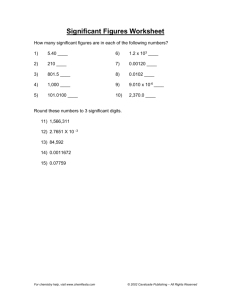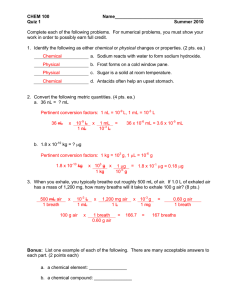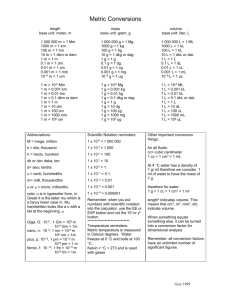Chapter 23. The Electric Force
advertisement
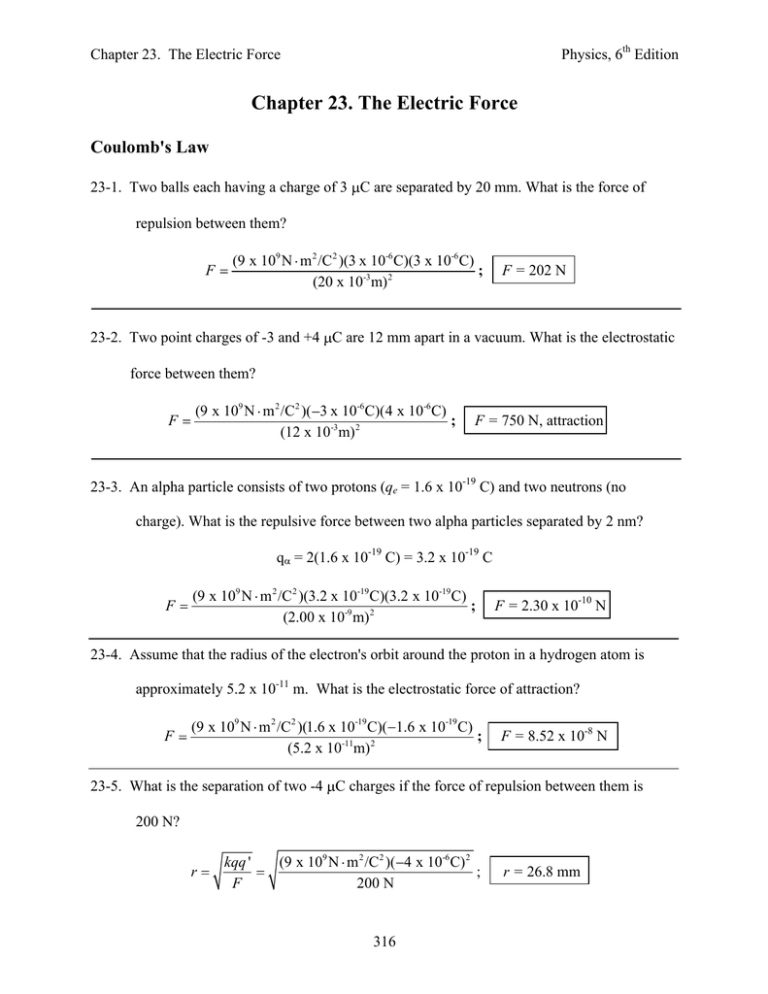
Physics, 6th Edition Chapter 23. The Electric Force Chapter 23. The Electric Force Coulomb's Law 23-1. Two balls each having a charge of 3 C are separated by 20 mm. What is the force of repulsion between them? F (9 x 109 N m 2 /C2 )(3 x 10-6 C)(3 x 10-6 C) ; (20 x 10-3m) 2 F = 202 N 23-2. Two point charges of -3 and +4 C are 12 mm apart in a vacuum. What is the electrostatic force between them? F (9 x 109 N m 2 /C2 )( 3 x 10-6 C)(4 x 10-6 C) ; (12 x 10-3 m) 2 F = 750 N, attraction 23-3. An alpha particle consists of two protons (qe = 1.6 x 10-19 C) and two neutrons (no charge). What is the repulsive force between two alpha particles separated by 2 nm? q = 2(1.6 x 10-19 C) = 3.2 x 10-19 C F (9 x 109 N m 2 /C2 )(3.2 x 10-19 C)(3.2 x 10-19 C) ; (2.00 x 10-9 m) 2 F = 2.30 x 10-10 N 23-4. Assume that the radius of the electron's orbit around the proton in a hydrogen atom is approximately 5.2 x 10-11 m. What is the electrostatic force of attraction? F (9 x 109 N m 2 /C2 )(1.6 x 10-19 C)( 1.6 x 10-19 C) ; (5.2 x 10-11m) 2 F = 8.52 x 10-8 N 23-5. What is the separation of two -4 C charges if the force of repulsion between them is 200 N? r kqq ' F (9 x 109 N m 2 /C2 )( 4 x 10-6 C) 2 ; 200 N 316 r = 26.8 mm Physics, 6th Edition Chapter 23. The Electric Force 23-6. Two identical charges separated by 30 mm experience a repulsive force of 980 N. What is the magnitude of each charge? F kq 2 ; q r2 Fr 2 k (980 N)(0.030 m) 2 ; 9 x 109 N m 2 /C 2 q = 9.90 C *23-7. A 10 C charge and a -6 C charge are separated by 40 mm. What is the force between them. The spheres are placed in contact for a few moments and then separated again by 40 mm. What is the new force? Is it attractive or repulsive? F (9 x 109 N m 2 /C2 )( 6 x 10-6 C)(10 x 10-6 C) ; (40 x 10-3 m) 2 F = 338 N, attraction 10 C -6 C When spheres touch, 6 C of charge are neutralized, 0.08 m leaving 4 C to be shared by two spheres, or 2 C 2 C +2 C on each sphere. Now they are again separated. 2 C 2 C 9 2 2 -6 -6 (9 x 10 N m /C )(2 x 10 C)(2 x 10 C) ; (0.080 m) 2 F 0.08 m F = 5.62 N, repulsion *23-8. Two point charges initially attract each other with a force of 600 N. If their separation is reduced to one-third of its original distance, what is the new force of attraction? F 1 ; r2 2 11 2 2 2 Fr Fr ; F2 3r2 F1 r2 F2 r2 F1 12 r2 r F1 1 r2 2 ; 2 9 F1 ; 317 F2 = 5400 N r1 = 3 r2 Physics, 6th Edition Chapter 23. The Electric Force The Resultant Electrostatic Force 23-9. A +60 C charge is placed 60 mm to the left of a +20 C charge. What is the resultant force on a -35 C charge placed midway between the two charges? F13 (9 x 109 N m 2 /C2 )(60 x 10-6 C)(35 x 10-6 C) (30 x 10-3m) 2 +60 C 60 mm -35 C +20 C q1 q3 q2 4 F13 = 2.10 x 10 N, directed to the left F23 F2 F1 (9 x 109 N m 2 /C2 )(20 x 10-6 C)(35 x 10-6 C) ; F13 = 2.10 x 104 N, directed to right. -3 2 (30 x 10 m) FR = F13 + F23 = (-2.10 x 104 N) + (0.700 x 104 N); FR = -1.40 x 104 N, left. 23-10. A point charge of +36 C is placed 80 mm to the left of a second point charge of -22 C. What force is exerted on third charge of +10 C located at the midpoint? F13 (9 x 109 N m 2 /C2 )(36 x 10-6 C)(10 x 10-6 C) (40 x 10-3 m) 2 +36 C 80 mm 10 C q1 q3 F13 = 2025 N, directed to the right F23 -22 C F1 q2 F2 (9 x 109 N m 2 /C2 )(22 x 10-6 C)(10 x 10-6 C) ; F13 = 1238 N, directed to right. (40 x 10-3 m) 2 FR = F13 + F23 = 2025 N + 1238 N; FR = 3260 N, left. 23-11. For Problem 23-10, what is the resultant force on a third charge of +12 C placed between the other charges and located 60 mm from the +36 C charge? F13 F23 (9 x 109 N m 2 /C2 )(36 x 10-6 C)(12 x 10-6 C (60 x 10-3m) 2 (9 x 109 N m 2 /C2 )(22 x 10-6 C)(12 x 10-6 C) ; (20 x 10-3 m) 2 Both to right, so FR = F13 + F23 = 1080 N + 5940 N; 318 80 mm +36 C q1 q3 = 12 C 60 mm F2 F = 7020 N, rightward. -22 C F1 q2 Physics, 6th Edition Chapter 23. The Electric Force 23-12. A +6 C charge is 44 mm to the right of a -8 C charge. What is the resultant force on a -2 C charge that is 20 mm to the right of the -8 C charge? (9 x 109 N m 2 /C2 )(8 x 10-6 C)(2 x 10-6 C) (20 x 10-3m) 2 F13 44 mm -8 C q3 = -2 C 24 mm 6 C q1 20 mm (9 x 109 N m 2 /C2 )(2 x 10-6 C)(6 x 10-6 C) ; (24 x 10-3m) 2 F23 F1 F2 Both to right, so FR = F13 + F23 = 360 N + 187.5 N; q2 F = 548 N, rightward *23-13. A 64- C charge is locate 30 cm to the left of a 16- C charge. What is the resultant force on a -12 C charge positioned exactly 50 mm below the 16 C charge? s (30 mm) 2 (50 mm) 2 tan F13 50 mm ; 30 mm +64 C 30 mm q2 16 C 58.3 mm q1 59.00 s 50 mm (9 x 109 N m 2 /C2 )(64 x 10-6 C)(12 x 10-6 C) (58.3 x 10-3m) 2 F1 F2 F13 = 2033 N, 59.00 N of W q3 = -12 C F23 (9 x 109 N m 2 /C2 )(16 x 10-6 C)(12 x 10-6 C) = 691 N, upward. (50 x 10-3 m) 2 Fx = 0 F13 cos 59.00 = -(2033 N) cos 590 ; Fx = -1047 N Fy = F23 + F13 sin 59.00 = 691 N + (2033 N) sin 590; F ( 1047 N) 2 (2434 N) 2 2650 N; tan 2434 N ; -1047 N Fy = 2434 N = 66.70 N of W. Resultant force: FR = 2650 N, 66.70 N of W (or 113.30) 319 Physics, 6th Edition Chapter 23. The Electric Force *23-14. A charge of +60 nC is located 80 mm above a -40-nC charge. What is the resultant force on a -50-nC charge located 45 mm horizontally to the right of the -40-nC charge? (45 mm) 2 (80 mm) 2 s tan +60 C 91.8 mm 80 mm ; 45 mm q1 60.640 s 80 mm (9 x 109 N m 2 /C2 )(60 x 10-6 C)(50 x 10-6 C) (91.8 x 10-3 m) 2 F13 F1 q2 F13 = 2564 N, 60.640 N of W 45 mm -40 C q3 = -50 C (9 x 109 N m 2 /C2 )(40 x 10-6 C)(50 x 10-6 C) = 8889 N, rightward. (45 x 10-3 m) 2 F23 Fx = F13 cos 60.640 + F23 = - (2564 N) cos 60.640 + 8889 N ; Fy = +F13 sin 60.640 + 0 = (2564 N) sin 60.640 ; F F2 (7632 N) 2 (2235 N) 2 ; tan 2235 N ; 7632 N Fx = 7632 N Fy = 2235 N = 16.30 N of E. FR = 7950 N, *23-15. Three point charges q1 = + 8 C, q2 = -4 C, and q3 = +2 C are placed at the corners of an equilateral triangle, 80 mm on each side as described by Fig. 23-15. What are the magnitude and direction of the resultant force on the +8 C charge? F21 (9 x 109 N m 2 /C2 )(4 x 10-6 C)(8 x 10-6 C) (80 x 10-3 m) 2 80 mm F21 = 45.0 N, 600 S of E F31 (9 x 109 N m 2 /C2 )(2 x 10-6 C)(8 x 10-6 C) (80 x 10-3m) 2 F31 = 22.5 N, 600 N of E; q1 = 8 C 600 600 F1 q3 +2 C 80 mm q2 = -4 C Fx = (22.5 N) cos 600 + (45 N) cos 600 = 33.8 N Fy = (22.5 N) sin 600 - (45 N) sin 600 = -19.5 N 320 80 mm Physics, 6th Edition Chapter 23. The Electric Force F *23-15. (Cont.) (33.8 N) 2 ( 19.5 N) 2 = 39.0 N; tan Resultant electric force: FR = 39.0 N, -19.5 N ; 33.8 N 300 = 330.00 Challenge Problems 23-16. What should be the separation of two +5-uC charges so that the force of repulsion is 4 N? r kqq ' F (9 x 109 N m 2 /C2 )(5 x 10-6 C) 2 ; 4.00 N r = 23.7 cm 23-17. The repulsive force between two pith balls is found to be 60 N. If each pith ball carries a charge of 8 nC, what is their separation? r kqq ' F (9 x 109 N m 2 /C2 )(8 x 10-9 C) 2 ; 60 x 10-6 N r = 98.0 mm 23-18. Two identical unknown charges experience a mutual repulsive force of 48 N when separated by 60 mm. What is the magnitude of each charge? F kq 2 ; q r2 Fr 2 k (48 N)(0.060 m) 2 ; 9 x 109 N m 2 /C2 q = 4.38 C 23-19. One object contains an excess of 5 x 1014 electrons and another has a deficiency of 4 x 1014 electrons. What is the force each exerts on the other if the objects are 30 mm apart? Is it attraction or repulsion? ( 1e = 1.6 x 10-19 C, excess = -, deficiency = +. ) q1 = (5 x 1014 e)(1.6 x 10-19 C/e) = -80 C; q2 = (4 x 1014 e)(1.6 x 10-19 C/e) = +64 C F (9 x 109 N m 2 /C2 )(80 x 10-6 C)(64 x 10-6 C) ; (30 x 10-3 m) 2 321 F = 5.12 x 104 N, attraction Physics, 6th Edition Chapter 23. The Electric Force 23-20. If it were possible to put 1 C of charge on each of two spheres separated by a distance of 1 m, what would be the repulsive force in newtons. F (9 x 109 N m 2 /C2 )(1 C)(1 C) ; (1 m) 2 F = 9 x 109 N ! The coulomb is a very large unit for electrostatics applications. 23-21. How many electrons must be placed on each of two spheres separated by 4 mm in order to produce a repulsive force of one 400 N? F kq 2 ; q r2 q 843 x 10-9C Fr 2 k (400 N)(0.004 m) 2 ; 9 x 109 N m 2 /C2 1e ; 1.6 x 10-19C q = 843 nC q = 5.27 x 1012 electrons 23-22. A 40-nC charge is placed 40 mm to the left of a +6-nC charge. What is the resultant force on a 12-nC charge place 8 mm to the right of the +6-nC charge? F1 (9 x 109 N m 2 /C2 )(40 x 10-9 C)(12 x 10-9 C) (48 x 10-3m) 2 F2 (9 x 109 N m 2 /C2 )(6 x 10-9 C)(12 x 10-9 C) ; (8 x 10-3 m) 2 Both to right, so FR = F1 + F2 = 1.88 mN 6 nC -40 nC q3 = -12 nC 8 mm 40 mm q2 q1 F1 F2 10.1 mN; F = -8.25 mN, leftward 23-23. A 5- C charge is placed 6 cm to the right of a 2- C charge. What is the resultant force on a 9 nC charge placed 2 cm to the left of the 2- C charge? F1 (9 x 109 N m 2 /C 2 )(9 x 10-9 C)(2 x 10-6 C) (2 x 10-2 m) 2 -9 nC 2 cm 2 C 6 cm q1 q2 F1 F1 = +405 mN, to right F2 322 5 C Physics, 6th Edition Chapter 23. The Electric Force F2 (9 x 109 N m 2 /C2 )(5 x 10-6 C)(9 x 10-9 C) ; (8 x 10-2 m) 2 Resultant force: F2 = +63.3 mN, to right FR = 405 mN + 63.3 mN; FR = 468 mN 23-24. An equal number of electrons is placed on two metal spheres 3.0 cm apart in air. How many electrons are on each sphere if the resultant force is 4500 N? F q kq 2 ; q r2 Fr 2 k 21.2 x 10-6C (4500 N)(0.03 m) 2 ; 9 x 109 N m 2 /C2 1e ; 1.6 x 10-19C q = 21.2 C q = 1.33 x 1014 electrons 23-25. A 4-nC charge is placed on a 4-g sphere that is free to move. A fixed 10- C point charge is 4 cm away. What is the initial acceleration of the 4- C charge? F2 (9 x 109 N m 2 /C2 )(4 x 10-9 C)(10 x 10-6 C) ; (4 x 10-2 m) 2 a F m 0.225 N 0.004 kg F2 = 225 mN a = 56.2 m/s2 *23-26. What is the resultant force on a +2 C charge an equal distance of 60 mm from each of two 4- C charges that are 80 mm apart in air? tan 40 mm ; 60 mm q1 = 2 C F1 48.20 F2 60 mm 60 mm F2 (9 x 109 N m 2 /C2 )(4 x 10-6 C)(2 x 10-6 C) (60 x 10-3m) 2 q2 = -4 C -4 C 40 mm F2 = 20.0 N, 48.20 S of E F1 q3 (9 x 109 N m 2 /C2 )(2 x 10-6 C)(4 x 10-6 C) ; (60 x 10-3 m) 2 323 F1 = 20.0 N, 48.20 S of W Physics, 6th Edition Chapter 23. The Electric Force *23-26. (Cont.) Fx = (20 N) cos 48.20 + (20 N) cos 48.20 = 13.33 N - 13.33 N; Fx = 0 Fy = (20 N) sin 48.20 + (20 N) sin 48.20 = 14.9 N + 14.9 N; Fy = -29.8 N Resultant force: FR = 29.8 N, downward *23-27. Two charges of +25 and +16 C are 80 mm apart. A third charge of +60 C is placed between the other charges 30 mm from the +25 C charge. Find the resultant force on the third charge? F1 80 mm (9 x 109 N m 2 /C 2 )(60 x 10-6 C)(25 x 10-6 C) (30 x 10-3 m) 2 25 C q1 30 mm q2 50 mm F1 F2 F1 = 15 kN, directed to the right F2 16 C q3 = 60 C (9 x 109 N m 2 /C2 )(60 x 10-6 C)(16 x 10-6 C) ; F13 = 3.46 kN, directed to left. (50 x 10-3 m) 2 FR = F1 + F2 = 15 kN + 3.46 kN); FR = 11.5 kN, right. *23-28. A 0.02-g pith ball is suspended freely. The ball is given a charge of +20 C and placed 0.6 m from a charge of +50 C. What will be the initial acceleration of the pith ball? F (9 x 109 N m 2 /C2 )(20 x 10-6 C)(50 x 10-6 C) ; (0.600 m) 2 a F m 25.0 N ; 2 x 10-5 kg F = 25.0 N a = 1.25 x 106 m/s *23-29. A 4 C charge is located 6 cm from an 8 C charge. At what point on a line joining the two charges will the resultant force be zero? F1 = F2 4 C F1 F2 ; kq3 q1 x2 kq3q2 (6 x) 2 x q2 324 6 cm - x q3 8 C q1 Physics, 6th Edition Chapter 23. The Electric Force F1 F2 ; q1 x2 Take square root of both sides: q2 ; (6 x) 2 x2 q1 (6 - x) = q2 x q1 (6 x) 2 q2 4 C (6 - x); 8 C x = 0.707(6 - x) Solving for x, we obtain: x = 2.49 cm from 4- C charge *23-30. A charge of +8 nC is placed 40 mm to the left of a 14 nC charge. Where should a third charge be placed if it is to experience a zero resultant force? F1 = F2 Considering the sign of the charges and their magnitudes, the charge must be to the q3 left of the 8 nC charge as shown. F1 F2 ; kq3 q1 x2 kq3 q2 (40 x) 2 F1 F2 ; q1 x2 -14 nC 8 nC x q2 ; (40 x) 2 40 mm q1 q2 q1 (40 x) 2 q2 x2 Take square root of both sides: x q1 8 nC (40 x) = (40 x); q2 14 nC x = 0.756(40+ x) Solving for x, we obtain: x = 124 mm left of 8 nC charge. *23-31. A +16- C charge is 80 mm to the right of a +9 C. Where should a third charge be placed so that the resultant force is zero? F1 F2 ; F1 kq3 q1 x2 F2 ; Take square root of both sides: kq3q2 (80 x) 2 q1 x2 q2 ; (80 x) 2 x F1 = F2 9 C q1 x2 x q3 80 mm - x q2 q1 (80 x) 2 q2 q1 9 C (80 - x) = (80 - x); q2 16 C x = 0.750(80 - x) Solving for x, we obtain: x = 34.3 mm from 9- C charge 325 +16 C Physics, 6th Edition Chapter 23. The Electric Force *23-32. Two 3-g spheres are suspended from a common point with two 80 mm light silk threads of negligible mass. What charge must be placed on each sphere if their final positions are 50 mm apart? T cos 25 mm ; 80 mm mg sin T = 71.80 Ty = T sin (3 x 10-3kg)(9.8 m/s 2 ) ; sin 71.80 kq 2 r2 F 9.67 mN; q Fr 2 k F = mg F mg T = 30.9 mN Tx = T cos 71.80 = (30.9 mN) cos 71.80; 80 mm Tx = 9.67 mN; 25 mm Fx = 0: (9.67 x 10-3 N)(50 x 10-3 m) 2 ; 9 x 109 N m 2 /C2 mg F = Tx q = 51.8 nC Critical Thinking Questions *23-33. A small metal sphere is given a charge of +40 C, and a second sphere 8 cm away is given a charge of 12 C. What is the force of attraction between them? If the two spheres are allowed to touch and are then again placed 8 cm apart, what new electric force exists between them? Is it attraction or repulsion? F (9 x 109 N m 2 /C2 )(12 x 10-6 C)(40 x 10-6 C) ; (0.080 m) 2 When spheres touch, 6 C of charge are neutralized, F = 675 N, attraction -12 C 40 C 0.08 m leaving 28 C to be shared by two spheres, or +14 C on each sphere. Now they are again separated: F (9 x 109 N m 2 /C2 )(14 x 10-6 C)(14 x 10-6 C) ; (0.080 m) 2 F = 276 N, repulsion 326 14 C 14 C 14 C 14 C 0.08 m Physics, 6th Edition Chapter 23. The Electric Force *23-34. The total charge on two metal spheres 50 mm apart is 80 C. If they repel each other 50 mm with a force of 800 N, what is the charge on each sphere? q1 + q2 = 80 C; F kq1q2 r2 kq1 (80 C - q1 ) ; r2 (800 N)(50 x 10-3m) 2 (9 x 109 N m 2 /C2 ) F kq1 (80 C ) kq12 ; r2 (80 C)q1 q12 ; q2 q1 q2 = 80 C q1 Fr 2 k (80 C)q1 q12 q12 (80 x 10-6 C)q1+ 222 x 10-12 C2 = 0 Solve the quadratic equation with a = 1, b = - 80 x 10-6, and c = 222 x 10-12 q1 = 77.1 C and q1 = 2.89 C Now q2 = 80 C q1 yields the following : q2 = 2.89 C and q2 = 77.1 C Thus, one charge is 77.1 C and the other is 2.89 C *23-35. Four small spheres are each given charges of q = +20 C and placed at the corners of a square with sides of length 6 cm. Show that the resultant force on each charge has a magnitude equal to 1914 N. What is the direction of the force? What will change if the charges are each q = -20 C? (Like charges repel, so sign doesn t matter.) R (6 cm) 2 (6 cm) 2 6 cm q 8.485 cm F1 F1 (9 x 109 N m 2 /C2 )(20 x 10-6 C)(20 x 10-6 C) (6 x 10-2 m) 2 6 cm F2 (9 x 109 N m 2 /C2 )(20 x 10-6 C)(20 x 10-6 C) (8.485 x 10-2 m) 2 q F1 = 1000 N; F2 F1 R 6 cm q 6 cm F2 = 500 N; For a square, the angle = 450 Fx = (1000 N) + (500 N) cos 450 + 0 = 1354 N; Fy = 1000 N + (500 N) sin 450 = 1354 N F (1354 N) 2 (1354 N) 2 ; F = 1914 N, 450 327 away from center. Physics, 6th Edition Chapter 23. The Electric Force *23-36. Two charges q1 and q2 are separated by a distance r. They experience a force F at this distance. If the initial separation is decreased by only 40 mm, the force between the two charges is doubled. What was the initial separation? 2kq1q2 x2 kq1q2 ; ( x 40 mm) 2 2 x2 1 ( x 40 mm) 2 F F x q1 q2 x 40 mm 2 x = 2(x 40 mm) x = 1.414(x 2 Take square root of both sides: 40 mm); q1 2F 2F q2 x = 137 mm *23-37. Two 8-g pith balls are suspended from silk threads 60 cm long and attached to a common point. When the spheres are given equal amounts of negative charge, the balls come to rest 30 cm apart. Calculate the magnitude of the charge on each pith ball. 0.15 m ; 0.60 m cos = 75.50 Ty = T sin = mg T 0.6 m F T mg sin -3 (8 x 10 kg)(9.8 m/s ) ; sin 75.50 Tx = T cos 71.80 = (81.0 mN) cos 75.50; F kq 2 r2 20.25 mN; F 2 q Fr 2 k T = 81.0 mN mg Tx = 20.25 mN; 0.15 m Fx = 0: (2.025 x 10-4 N)(0.30 m) 2 ; 9 x 109 N m 2 /C2 328 mg F = Tx q = -450 nC This document was created with Win2PDF available at http://www.win2pdf.com. The unregistered version of Win2PDF is for evaluation or non-commercial use only.

